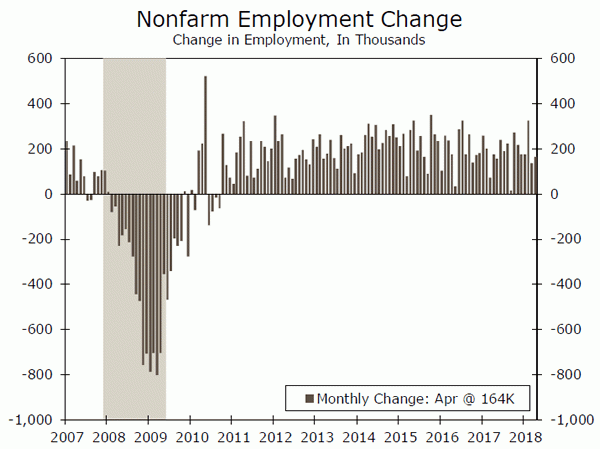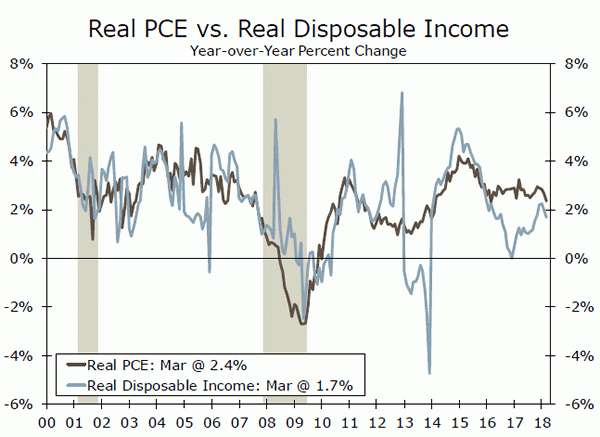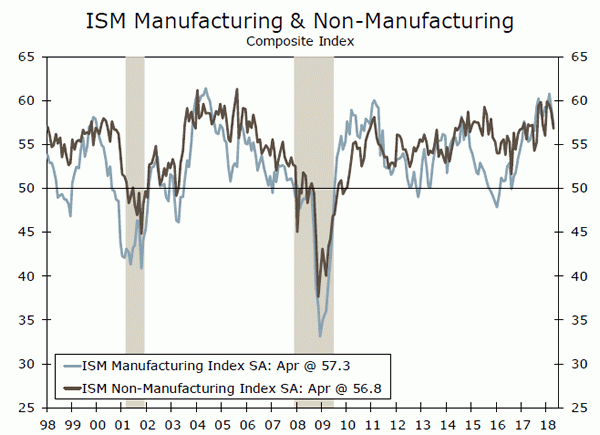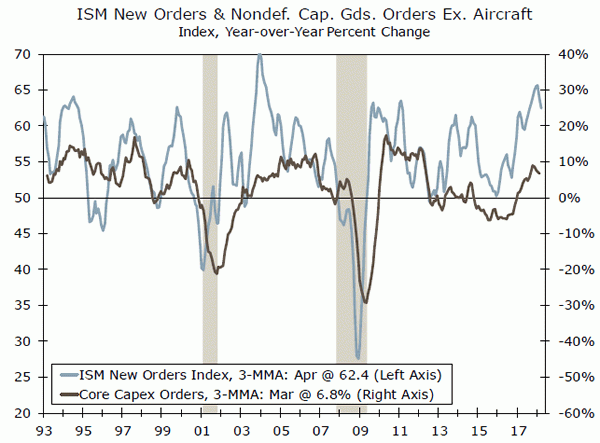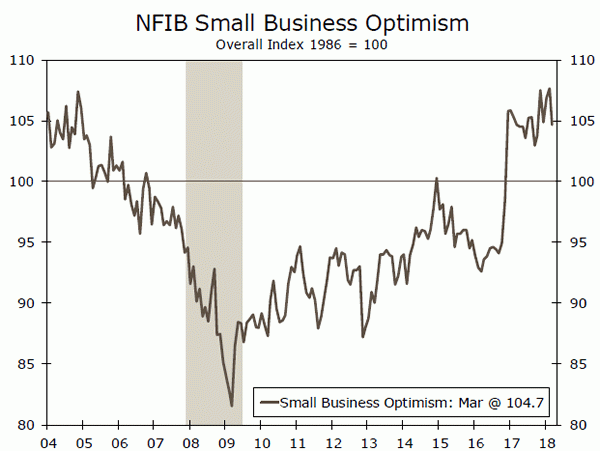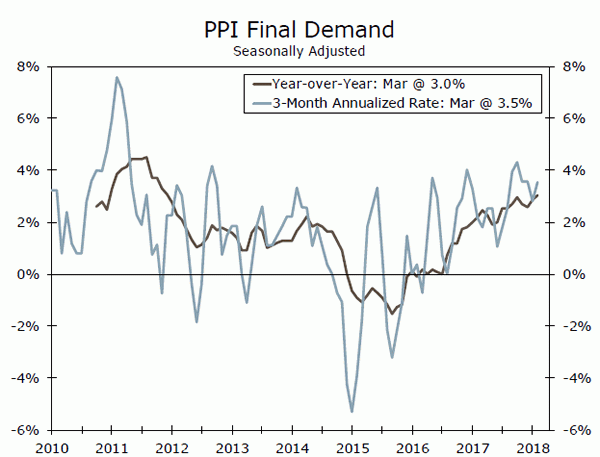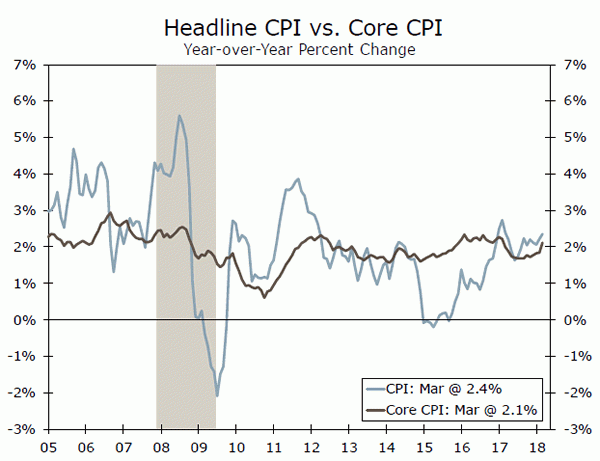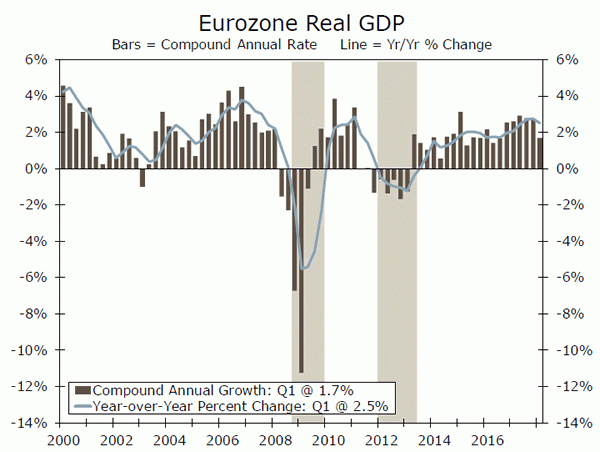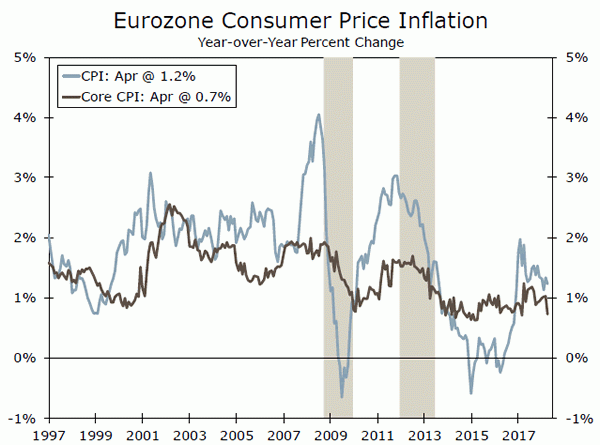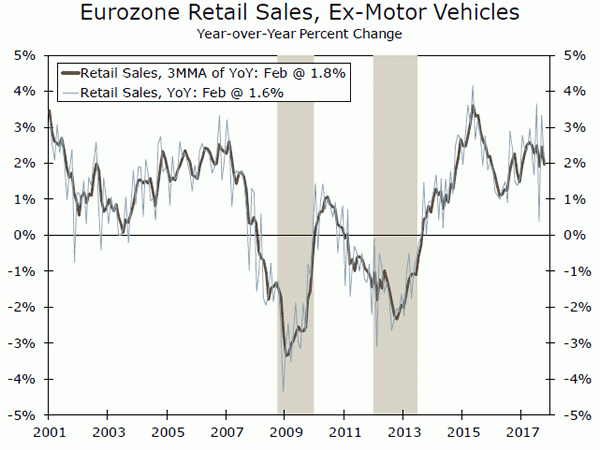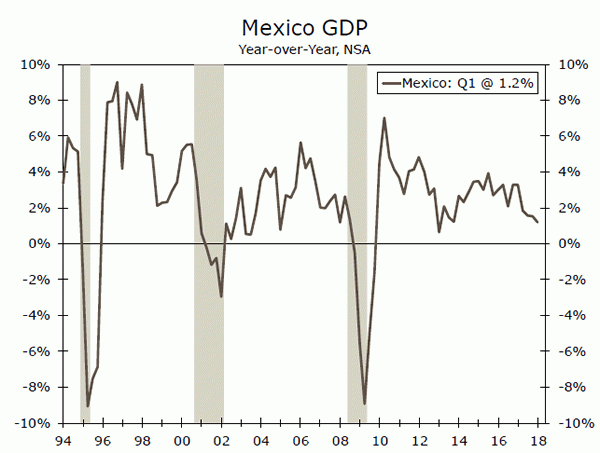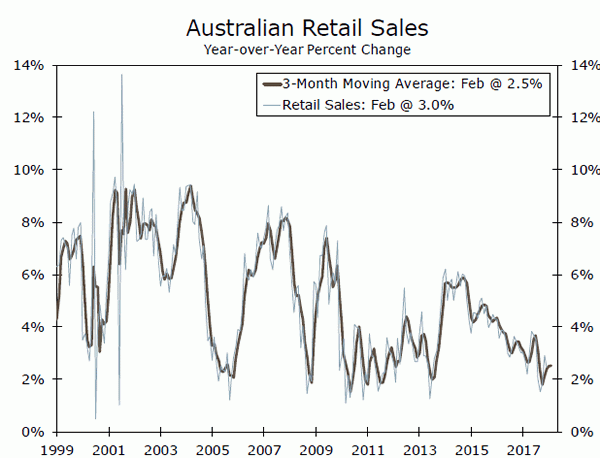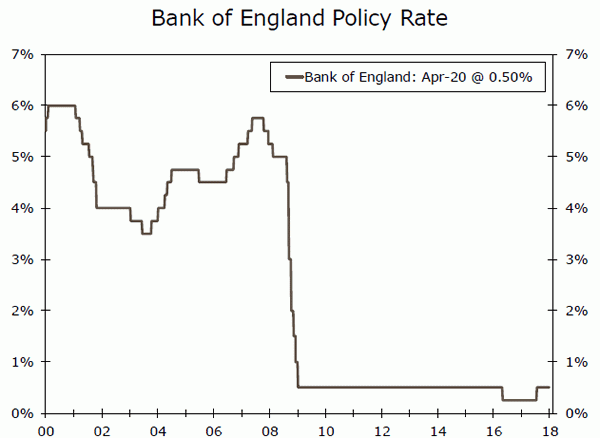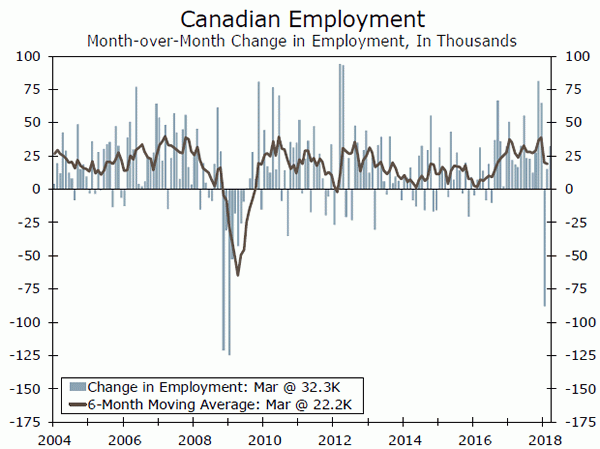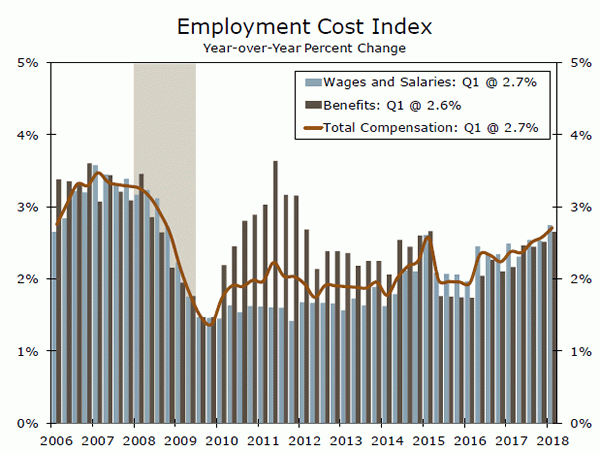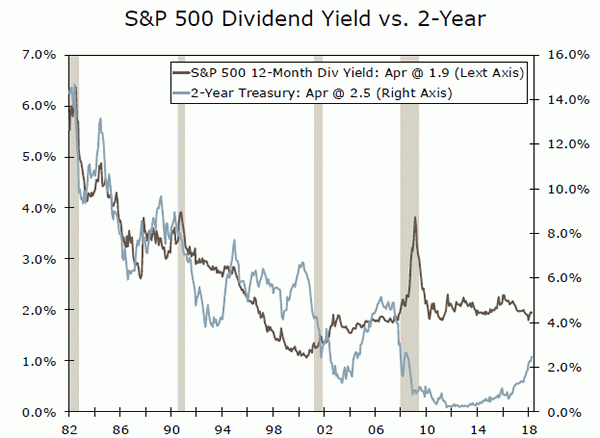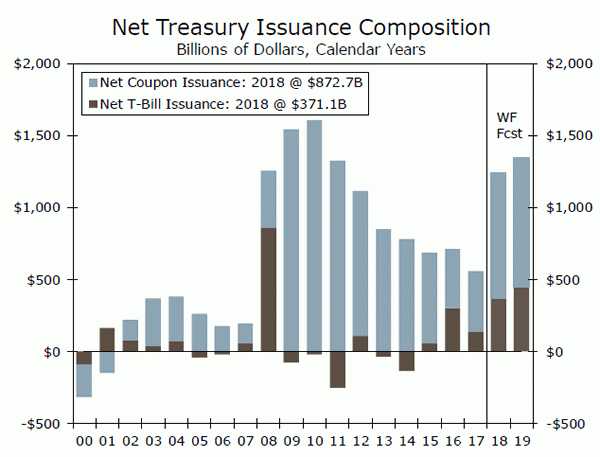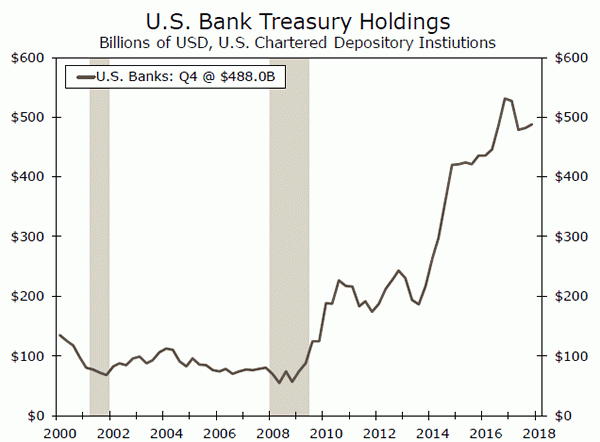U.S. Review
Solid Payroll Gain and Jobless Rate Falls to 3.9 Percent
- This morning’s jobs report ended a busy week of data on a solid note. The economy added 164,000 jobs in April, and the jobless rate fell 0.2 percentage points to 3.9 percent. The payroll gain was less than the consensus estimate, as we expected, but still represented a solid rebound from March and pointed to strong underlying demand for labor.
- Other reports from across the economy this week were largely supportive of our view that growth is set to pick up modestly as the year progresses and the Federal Reserve should continue to raise interest rates. We expect the next increase will be in June with two more by the end of the year.
Data Releases Mostly Come in Lukewarm
The data calendar was packed this week and largely reinforced the Fed’s view that the economy is growing moderately with roughly balanced risks to the outlook. The personal income and spending report showed an encouraging spending rebound in March. Consumer spending rose 0.4 percent during the month on both a real and nominal basis. The 0.4 percent rise came on the heels of a weaker February gain, with nominal spending flat and real spending declining 0.2 percent. We already knew that consumer spending took a breather in Q1 from last week’s GDP report, which showed only a 1.1 percent acceleration in Q1 PCE. The solid print in March suggests spending had solid momentum going into the second quarter, which gives us more confidence in our call for a solid bounce back. Moreover, fundamentals point to more consumption in Q2. The strong job market has supported income growth, though March’s increase was a bit slower. The report also showed the PCE deflator, the Fed’s preferred inflation gauge, hit the year-over-year target of 2 percent in March. That confirmation should encourage the FOMC to forge ahead with its plans to increase interest rates, and we expect the next move will be in June. Rising interest rates are likely to put further pressure on those seeking to purchase a home. Many homebuyers are facing a dearth of available inventory in their price range. Pending home sales for March showed a smaller-than-expected rise of 0.4 percent, and the number of signed contracts remained below their year-ago level for the third straight month. Residential construction spending also declined in March, contributing to the 1.7 percent decline in overall outlays. January and February’s outlays were revised higher and spending remains up year to date, suggesting construction activity is still gaining momentum despite the disappointing report in March.
The factory sector is growing, although it may be approaching capacity as strong demand both domestically and abroad is testing production limits. The ISM manufacturing survey slipped again in April but remains close to its February high and still points to solid expansion in coming months. Responses reiterated concerns that limited labor supply and supply chain disruptions are restraining production. Delivery times have lengthened and backlogs rose to a 14-year high. This contributed to higher prices paid for many industries, which will likely push up consumer prices as costs are passed along or eat at profit margins. Headline factory orders rose in March, representing a surge in commercial aircraft orders. The underlying details were less indicative of increasing growth in business equipment spending. Core capital goods orders and shipments were down on the month. Business equipment has boosted topline GDP in each of the past six quarters, but the softening in core orders suggests the fastest quarterly growth rates may be behind us.
Non-manufacturing prices paid also increased in April to its strongest reading since 2012, excluding hurricane-induced spikes. The non-manufacturing ISM composite also eased in April but remains elevated, pointing to continued growth in the services and construction sectors.
U.S. Outlook
NFIB Small Business Optimism • Tuesday
The NFIB index pulled back in March, but small businesses continue to exude a high degree of optimism about the economy. Hiring plans, capital spending expectations and the share of firms seeing stronger profits all remain near the highs of the current expansion.
The NFIB index is expected to be little changed in April, although we note some potential for weakening following another month of contentious trade talk. Other business surveys point to some softening in recent business conditions, including both ISM surveys and the latest Wells Fargo Small Business Survey. All continue to sit at fairly high levels, however, and suggest small business optimism remained strong last month.
Previous: 104.7 Consensus: 105.0
Producer Price Index • Wednesday
Producer price inflation came in slightly above expectations in March with a gain of 0.3 percent and has been rising steadily over the past year. The rebound in oil has helped fuel the pickup, but price growth has strengthened for core components as well. Services costs in particular have gained momentum, rising at a 3.5 percent annualized rate in the three months through March.
We expect the PPI for final demand to moderate slightly in April, with the index increasing 0.2 percent from March and 2.8 percent compared to last April. Energy costs were higher last month, but we expect some payback from an unusually large rise in food prices. Pipeline pressures also eased a touch in March, with prices for intermediate goods falling and price growth for intermediate services moderating after a strong rise in February.
Previous: 0.3% Wells Fargo: 0.2% Consensus: 0.2% (Month-over-Month)
Consumer Price Index • Thursday
Consumer price inflation fell in March for the first time in a year. The o.1 percent drop was entirely driven by a pullback in energy costs. We expect to see a reversal of this dynamic in April. According to AAA, gasoline prices rose 6.2 percent last month, which is a bit more than usual for this time of year.
In contrast to the headline, core inflation posted another solid gain in March. The core index in recent months has advanced at the strongest pace since 2011. A revival in core goods prices has helped spur the pickup, but renewed pressure on vehicle prices and the halt in the dollar’s slide suggest support from this category could fade. Core services inflation, however, remains strong, helped by higher shelter, medical and transport costs.
All told, we anticipate the CPI rose 0.3 percent last month, with the core index increasing 0.2 percent.
Previous: -0.1% Wells Fargo: 0.3% Consensus: 0.3%
Global Review
Eurozone GDP Slows in Q1; Mexico Adds to Uncertainty
- The Eurozone economy grew 0.4 percent in Q1, not annualized, and by 2.5 percent on a year-earlier basis. This performance matched market expectations.
- Eurozone consumer prices increased just 1.2 percent on a yearearlier basis versus expectations of a 1.3 percent increase. This was down from a 1.3 percent print for the year ending in March.
- Large discrepancies between the seasonally-adjusted data and non-seasonally adjusted data for Mexican GDP in Q1 is adding to the political uncertainty hitting the country due to the upcoming presidential elections. Andrés Manuel López Obrador (AMLO) is expected to win if political surveys are any guide.
Eurozone GDP Slows a Bit in Q1
For weeks now, markets have been reacting to several weaker economic data points coming from the Eurozone. This is in contrast to the relatively strong pace it exhibited during the last quarter of last year. The release of the advanced number for GDP growth in the Eurozone for Q1 confirmed what markets had been pricing for a while. According to the report, the Eurozone economy grew 0.4 percent in Q1, not annualized and by 2.5 percent on a year-earlier basis. This performance matched market expectations. However, not all the news on the economy was weaker as the result for Q4-2017 was revised slightly upwards from an original 0.6 percent, not annualized sequential growth, to 0.7 percent. Meanwhile, the year-over-year gain was revised up from 2.7 percent to 2.8 percent, which makes the 0.4 percent sequential growth and the 2.5 percent print in Q1 a little bit stronger than what markets were expecting.
Perhaps the biggest concern for the European Central Bank (ECB) was the news on inflation, which also came in below market expectations. Consumer prices increased just 1.2 percent on a yearearlier basis versus expectations of a 1.3 percent increase. This was down from a 1.3 percent print for the year ending in March. Furthermore, the core CPI was even lower on a year-earlier basis, increasing 0.7 percent compared to a 1.0 percent rate in March, year over year. The fact that core prices are still slowing down will keep the ECB from changing monetary policy any time soon. Eurozone retail sales increased less than expected 0.1 percent in March, month on month, compared to market expectations of a 0.5 percent increase. At the same time, the year-over-year rate declined from 1.8 percent in February to just 0.8 percent in March. Markets were expecting the year-over-year rate at 1.9 percent. However, it was not all bad news as the February month-on-month print was revised up from 0.1 percent to 0.3 percent.
Mexican Economy Adds to Uncertainty in Q1.
Large discrepancies between the seasonally-adjusted data and non-seasonally adjusted data for Mexican GDP in Q1 is adding to the political uncertainty hitting Mexico due to the upcoming presidential elections. Andrés Manuel López Obrador (AMLO) is expected to win if political surveys are any guide.
The Mexican economy grew a strong 1.1 percent sequentially and seasonally-adjusted in Q1 while growing 2.4 percent compared to a year earlier. However, the non-seasonally adjusted performance in Q1 compared to the same quarter a year earlier showed a weaker economy, up only 1.2 percent. The mismatch between seasonally and non-seasonally adjusted results has to do with the Easter season falling mostly in Q1 this year compared to last year. However, we believe that both numbers may not reflect the true state of the Mexican economy. That is, the economy’s performance is probably not as strong as the seasonally-adjusted numbers reflect, while it is not as weak as the non-seasonally adjusted numbers show. Thus, we will wait for more information on Q2 to make adjustments to our current call on Mexican GDP growth, which stands at 1.9 percent for the whole of 2018.
Global Outlook
Australian Retail Sales • Tuesday
Retail sales were up 0.6 percent in February, which was the strongest month-over-month increase since November 2017. This rise in spending was broad based, with sales increasing across all major categories in February. Despite this rise in spending, household consumption continues to be a key area of uncertainty for the Reserve Bank of Australia, which had elected to keep its key lending rate unchanged at 1.50 percent at its March meeting. Weak wage growth and high household debt levels continue to weigh on household consumption. Despite expectations that inflation growth will likely remain lackluster for some time, we expect to eventually see the continued improvement in the labor market translate into higher wages. Strong competition among retailers as well as difficulty finding skilled workers will eventually cause price pressures to materialize, while fostering conditions for increased consumption.
Previous: 0.6% (Month-over-month) Consensus: 0.3%
Bank of England Meeting • Thursday
Real GDP in the United Kingdom grew just 0.1 percent in the first quarter, well below market expectations of 0.3 percent. While some of the first quarter weakness may be due to bad winter weather, the slower overall pace of growth raises questions about the underlying health of the British economy. Despite the more hawkish rhetoric of the Monetary Policy Committee (MPC) following their March meeting, we expect the weaker-than-expected first quarter GDP print to likely cause a “wait and see” policy approach of the MPC at the Bank of England. We now expect the MPC to remain on hold until August, as they examine incoming economic data in coming months prior to further tightening policy. We expect inflation to continue to recede, which should spur growth in real income and consumer spending in the quarters ahead. Conditions should foster stronger growth, which would be supportive of further rate hikes from the MPC, albeit at a gradual pace.
Previous: 0.50% Wells Fargo: 0.50% Consensus: 0.50%
Canadian Employment • Friday
Employment growth started the year mixed in Canada. After surprising to the downside in January, by posting a flat-out decline, employment has regained strength in February and March. The 32,300 increase in new jobs in March helped keep the unemployment rate at 5.8 percent for the second consecutive month. The only other time the unemployment rate has reached this historically low level was in 2007. Average hourly earnings have also continued to strengthen since bottoming in April 2017. Canada’s tight labor market conditions could begin to start seeing some signs of cooling as it nears full capacity. The economy grew a breakneck 3.0 percent in 2017 as a whole, while industrial capacity utilization rates edged up throughout the year. Conditions are supportive of rising inflationary pressures, as core measures of CPI have continued to edge higher, and will likely remain supported by resource constraints and steady wage increases.
Previous: 32,300 Consensus: 19,600
Point of View
Interest Rate Watch
Inflation, FOMC and 2-Year
Over the past week, economic information, policy pronouncements and a hypothesized link between the two year yield and dividend yields have caught the markets attention.
Compensation, Not Wages, are Focus
Labor costs are rising amid a tight labor market. Despite all the commentary about low/sluggish wages, the hype misses the reality. As evidenced in the top graph, labor compensation has been steadily rising since late 2016, with both benefits and wages on the upswing. In the modern labor market, wages alone do not tell the story of a tight labor market. Workers have broadened their concerns to include benefits—such as health care and pension benefits.
The Employment Cost Index for private industry is up 2.9 percent year-over-year and this rise in compensation is consistent with the drop in the unemployment rate since 2010—even though the common perception is that labor compensation is not linked to lower unemployment—benefits matter—not just wages.
FOMC and That 2% Target-A Fourth?
Earlier this week, the headline year-overyear PCE deflator hit the 2 percent FOMC target, as illustrated in the middle graph. Moreover, the headline PCE deflator has risen at a 2.4 percent pace over the past three months. This supports the view that the FOMC will raise the fed funds rate again in June (June 13 will be the press conference with a new dot plot).
What we will be watching, will be if the FOMC adds a fourth rate hike in 2018 and to what extent the FOMC emphasizes that their 2 percent target is flexible and will allow for a period of above 2 percent inflation.
Two-Year Rate and Dividend Yield
As the two-year Treasury rate has risen over the past year, there has been commentary that rising rates will be competition for equities. As illustrated in the bottom graph, there would appear to be some linkage. While the two-year yield did lead to changes in dividend yields from 1982-1999, that link has since disappeared.
Credit Market Insights
Update on the Consumer
Last week, the University of Michigan Consumer Sentiment Survey for the month of April was released. Overall consumer sentiment fell 2.6 points on the month, with the drop coming from a 6.3 point decline in consumers’ assessment of current economic conditions.
Unsolicited comments from participants are kept track by the survey. Favorable views on taxes were mentioned more than three times more often than unfavorable tax reform mentions. What likely dragged down the current assessment of consumers is concern over trade policy and tariffs. Twenty-four percent of consumers mentioned trade restrictions and tariffs in a negative light in the midst of NAFTA negotiations and trade rhetoric with China.
The survey also showed that more than half of respondents noted improved household finances over the past year, with just 15 percent saying they have worsened. The improvement of household finances bodes well for sales of homes and motor vehicles. Sixty-nine percent of consumers feel that now is a good time to buy a vehicle, with just 25 percent saying now is a bad time. Similarly, 71 percent of consumers in the survey feel that now is a good time to buy a home, marking the fourth consecutive monthly increase.
Consumers essentially feel confident about their personal and household finances, but express some nervousness surrounding protectionist trade rhetoric and potential tariffs.
Topic of the Week
Till Debt Do Us Part
On Wednesday, the U.S. Treasury released its Quarterly Refunding Statement, which outlines the government’s borrowing intentions over the next few months. Auction sizes for coupon-bearing Treasuries were once again increased across-the-board to help meet the federal government’s rapidly rising borrowing needs.
As illustrated in the top chart, we expect net Treasury issuance to skyrocket this year and next. The jump in issuance has been driven by both technical and fundamental factors. On the technical side, the Treasury operated under the debt ceiling for much of 2017, creating a backlog of debt in the pipeline that was issued in Q1-2018 once the debt ceiling was suspended. Net T-bill issuance was $333 billion in Q1, the most since Q4- 2008, when skyrocketing deficits and financial market turmoil warranted a flood of short-term, highly liquid U.S. debt.
On the fundamental side, the triple whammy of tax cuts, the recent budget deal and Federal Reserve balance sheet redemptions have significantly increased the amount of money that must be raised from the public at auction. Structural factors related to the aging of the population and rising interest rates are also contributing to underlying deficit pressures.
This surge in supply naturally raises the question: who will buy all this new debt, and at what price? In our view, some of the most robust sources of demand over the past few years are likely to see the pace of their purchases slow. U.S. banks, for example, were a major net buyer of Treasury securities over the past few years as financial institutions bought Treasuries to grapple with a slew of new bank regulations (bottom chart). The pace of buying appears to have slowed recently, however, and the Trump administration has signaled a desire to make financial regulation less onerous going forward.
We have written extensively on this topic from both the supply and demand side, and this series of reports is available upon request.




